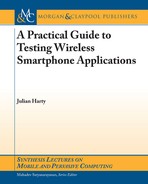0%
27Chapters
0-1Hours read
0kTotal Words
Book Description
Testing applications for mobile phones is difficult, time-consuming, and hard to do effectively. Many people have limited their testing efforts to hands-on testing of an application on a few physical handsets, and they have to repeat the process every time a new version of the software is ready to test. They may miss many of the permutations of real-world use, and as a consequence their users are left with the unpleasant mess of a failing application on their phone. Test automation can help to increase the range and scope of testing, while reducing the overhead of manual testing of each version of the software. However automation is not a panacea, particularly for mobile applications, so we need to pick our test automation challenges wisely. This book is intended to help software and test engineers pick appropriately to achieve more; and as a consequence deliver better quality, working software to users. This Synthesis lecture provides practical advice based on direct experience of using software test automation to help improve the testing of a wide range of mobile phone applications, including the latest AJAX applications. The focus is on applications that rely on a wireless network connection to a remote server, however the principles may apply to other related fields and applications. We start by explaining terms and some of the key challenges involved in testing smartphone applications. Subsequent chapters describe a type of application e.g. markup, AJAX, Client, followed by a related chapter on how to test each of these applications. Common test automation techniques are covered in a separate chapter, and finally there is a brief chapter on when to test manually. The book also contains numerous pointers and links to further material to help you to improve your testing using automation appropriately. Table of Contents: Introduction / Markup Languages / Testing Techniques for Markup Applications / AJAX Mobile Applications / Testing Mobile AJAX Applications / Client Applications / Testing Techniques for Client Applications / Common Techniques / When to Test Manually / Future Work / Appendix A: Links and References / Appendix B: Data Connectivity / Appendix C: Configuring Your MachineTable of Contents
- Cover Page
- Copyright Page
- Title Page
- Preface
- What is Inside
- Conventions
- What you will Need
- Using Code Examples
- Alphabet Soup and the Half-Life of Links
- Acknowledgments
- Contents
- 1 - Introduction
- 1.1 - What Is a Mobile Wireless Application?
- 1.2 - Classifications of Mobile Wireless Applications
- 1.3 - Currently Outside the Scope of This Book
- 1.4 - Scope of Mobile Wireless Test Automation
- 1.5 - Challenges in Testing Mobile Wireless Applications
- 1.6 - Problem Space
- 1.7 - Our Testing Focus
- 1.8 - Our Goals When Testing
- 1.9 - Our Overall Testing Strategy
- 1.10 - Core Concepts
- 2 - Markup Languages
- 3 - Testing Techniques for Markup Applications
- 3.1 - Getting Started With Test Automation
- 3.2 - Examples Written in Python
- 3.3 - Summary of the Examples in Python
- 3.4 - Building on Your First Automated Scripts
- 3.4.1 - Data-Driven Tests
- 3.4.2 - Obtaining Metadata to Drive Our Tests
- 3.4.3 - Using Metadata
- 3.4.4 - Test Using Carrier Networks
- 3.4.5 - Timing the Request/Response Pair
- 3.4.6 - Implementing Rule-Based Tests
- 3.4.7 - Probe Servers
- 3.4.8 - Strengths and Weaknesses of Rule-Based Testing
- 3.4.9 - A Complementary Tool to Rule-Based Tests
- 3.4.10 - Is Appropriate Content Being Served?
- 3.5 - Tips When Implementing Automated Test Scripts
- 3.6 - Test Tools for Browser-Based Applications
- 4 - AJAX Mobile Applications
- 5 - Testing Mobile AJAX Applications
- 6 - Client Applications
- 7 - Testing Techniques for Client Applications
- 8 - Common Techniques
- 9 - When to Test Manually
- 10 - Future Work
- Appendix A Links and References
- Appendix B Data Connectivity
- Appendix C Configuring your Machine
- Author Biography
